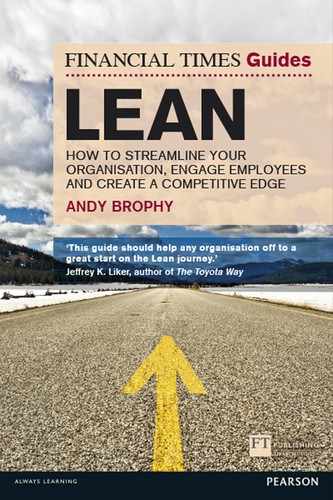Introduction
Lean has evolved in the past decade or so from beyond being principally applied in the manufacturing sector to gaining widespread acceptance in almost all industries. It is a deep and profound management system for the attainment of balanced performance excellence.
The current demanding global economic conditions have created an environment where being Lean and fit is now an operational imperative. Lean is no longer a ‘nice to do’ activity that you will get around to when you get on top of the pressing day-to-day issues. Lean offers an alternative from cutting your way to improving your way through challenging business conditions. This book aims to be your consultative guide to getting started on the Lean journey, to provide guidance on the core Lean transformation practices, and finally to articulate the leadership skills and behaviours required to both navigate the journey and sustain the gains.
Book overview
Part 1 – Getting started: Lean orientation and diagnostic phase
Chapter 1 describes the five guiding principles of Lean that guide the transition towards excellence and the two equally important pillars of continuous improvement and respect for people. A brief history of the evolution of Lean is charted. The business case for Lean is outlined in generic terms to build tension for change for readers. The Lean trilogy of muda, muri and mura is introduced to outline a powerful catalyst for change.
Chapter 2 details how to both align Lean with the overall business strategy and accelerate the delivery of the agreed strategic objectives. The process for the accomplishment of this dual aim is known as hoshin kanri strategy deployment.
Chapter 3 illustrates a case study in value stream mapping from a hospital setting. Value stream mapping is a powerful diagnostic methodology for identifying obstacles to the end-to-end flow of value in your organisation. The process moves through three phases; namely, identifying the existing state, designing perfection and finally the creation of a realistic future state map with a plan to arrive there.
Part 2 – Lean transformation practices
Chapters 4 through 9 present the core Lean practices that collectively are designed to bring abnormal conditions and problems to the surface rapidly. The design of the Lean system creates tension to solve these problems when they are still small and relatively easy to crack. The effect is an organic system of living improvement through everyday problem solving.
Part 3 – Leading the Lean transformation
Chapter 10 tackles the hard–soft side of Lean transformation. The development of the culture for Lean to thrive takes deliberate nurturing. Frank Devine’s Cathedral model for accelerated cultural change cultivates the behavioural changes required for performance excellence.
Chapters 11 and 12 take a deep dive into the technical and people dimensions of sustaining and producing a continuous stream of improvement activity. This requires a blend of both management and leadership: leadership to produce change and management to lock in the progress towards the ideal state identified in the diagnostic phase of Lean deployment.
Finally Chapter 13 knits the book together through the development of a generic roadmap for transformation that will serve as your guide and barometer along the various stages of Lean maturity. No two Lean journeys will look the same but there are guiding sequences of milestones along the journey that will help you stay the course.
How to read this book
The book is split into three discrete parts:
- Part 1 – Getting started: Lean orientation and diagnostic phase
- Part 2 – Lean transformation practices
- Part 3 – Leading the Lean transformation
I recommend that you read the book in the following order:
- Read Part 1, Chapters 1 to 3 to familiarise yourself with the Lean philosophy and diagnostic methods that deeply uncover the current state of your organisation and provide a baseline for improvement. This part also (in Chapter 2) frames Lean in a strategic context to ensure that Lean management is not viewed simply as a set of tools that you can bolt onto your existing management system.
- Armed with your current performance baseline and gap analysis from Part 1 you can then acquaint yourself with the core Lean methods and tools in Part 2. Need should drive change, therefore the methods selected here should be deployed to address problems identified in the diagnosis phase in Part 1. For example, if your organisation is struggling to meet customer demand you might select quick changeover and total productive maintenance (Chapter 7) to increase the capacity of current equipment. You could then deploy a kaizen event (Chapter 6) to compress the time for the impact of these Lean methods to hit the bottom line.
- Part 3 mainly covers the leadership and human side of transformation. Technical elements for sustaining the gains are discussed in Chapter 11. Chapter 13 covers the Lean roadmap and is really useful for providing context of where you are and what you need to do next (again dependent on need). I recommend you read this chapter before sustaining the gains (Chapters 11 and 12), but these will soon be required! Chapter 10 covers the cultural enrichment aspects that are required for sustained Lean transformation. Cultural change is profoundly influenced by management actions. It would be helpful to have a grasp of this chapter when tending to the ‘soft’ side of improvement work so keep this chapter to hand when you are building consensus among your senior leadership team that Lean is the strategic weapon that the organisation is committing towards, to drive long-term operational excellence.
